We’re happy to have another guest article for you today, this time written by Ronaldo Olive of Brazil. This was originally printed in Combat Handguns in the 1980s, and we’re reprinting it with Ronaldo’s permission – thanks, Ronaldo! Folks looking for Portuguese-language reference books should definitely check out the several ebooks Ronaldo has available on firearms and aircraft.
A Fistful of Firepower
by Ronaldo Olive
It is an undeniable fact that some firearms do have an aura of mysticism surrounding them. One such example is the Mauser 7.63mm Military Model pistol a definitely popular weapon in the beginning of the Century, and more so around the 20s and 30s. The last examples were produced in 1938, and the “broomhandle” (from its characteristic wooden grip) is unlikely to be found in the active inventory of any world’s military or police forces…except for Brazil! Yes, Rio de Janiero State’s ‘Policia Militar’ (Military Police) still has a reasonable number of these German-made pistols in use, though they are scheduled to be soon replaced with locally-made submachine guns [Ian’s note – since this article was written back in the 80s, we expect all the Mausers are retired by now].
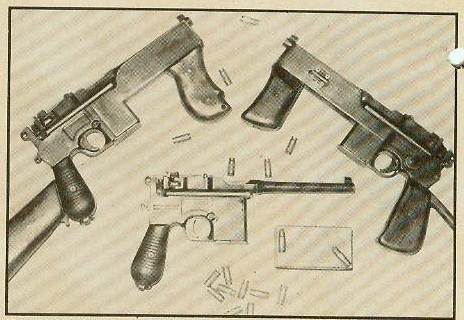
The Brazilian weapons are of the type usually known as the “Schnellfeuer-pistole” (rapid-fire pistol), a selective-fire model introduced by Waffenfabrik Mauser in the early 30s to counter the competition of the Spanish-made copies (Royal and Astra) which, unlike the original design, began to appear in the market offering full-auto capability. Though the actual usefulness of such light guns in the automatic mode was already open to question, they did represent a solid market those days, even if it were for “status symbol” purposes. And this was not ignored by the German firm.
Joseph Nickl, an Austrian-born employee at the Oberndorf factory, was given the responsibility to redesign the pistol’s action accordingly, and patents were issued in Germany in 1930, and in the United States four years later (US Patent #2,058,746, K. Westinger, “Quick Firing Pistol”, February 16, 1933). The resulting weapon externally resembled, to all extents and purposes, the C/96 (Construction 1896) Military Model, but featured a fire selector lever on the left side of the frame, between the pistol grip and the trigger guard, with settings for semi-automatic (“N”, forward) and automatic (“R”, to the rear) fire. The original feeding system, a 10-round clip which was inserted from the top into the open action, was replaced with a more conventional box magazine, of 10-round capacity in most cases (a 20-round magazine was also used). Like all other Mauser “broomhandle” pistols, the selective-fire variants were sold with the characteristic wooden holster, which could be attached to the grip to act as a shoulder stock, thus converting the weapon into a “mini” carbine.
Reported malfunctions on some Nickl-designed models (of which only about 4,000 were manufactured) led Mauser to further redesign the weapon, the improved mechanism being the brainchild of Karl Westinger. This was a remarkable success, and the production run, between 1931 and 1938, totaled some 98,000 guns. The most obvious external difference was the fire selector lever, a semi-circular job with a pointed tip, locked in position by a spring-loaded button in the center.
Although the 7.62mm Mauser never achieved a remarkable military sales success, it was no doubt a great commercial hit, notably in China and Spain. Police and military forces of a dozen or so countries acquired quantities of the weapons during the 30s, and Brazil was one of them. Though it was not officially adopted by the Army, a number of Police forces did order it, one of them being the Policia Militar do Distrito Federal (Federal District Military Police), which purchased about 500 in the mid-30s. They were all of the “Schnellfeuer” model, with 10-round detachable box magazines, and most of these are still in use by what is now “Policia Militar do Rio de Janeiro” (Rio de Janeiro Military Police). The guns are locally referred to as the PASAMs (Pistolas Automaticas e Semi-Automaticas Mauser, or Mauser Automatic and Semi-Automatic Pistols).
But the Brazilians – like probably everybody else – were soon to learn that the full-auto capability of the Mausers didn’t, after all, have much effectiveness. With a rate-of-fire in the region of 850-900 rounds per minute, magazines were emptied in slightly over one second (!), and controllability was all but nonexistent, even with use of the holster/stock.
In 1970, a palliative step was given by PMRJ by asking a local gunsmith (Spanish-born Jener Damau Arroyo, who reportedly served with the British Army in World War II) to modify a number of the weapons to improve their handling characteristics. The first model, of which 101 were modified, received a metal frame extension welded to the magazine housing, and was fitted with a metal forward grip well ahead of the gun, under the muzzle. The original grip was retained, and thus the characteristic wooden holster/stock could be attached to it. A second modification, involving 89 pistols, featured a similar frame extension, but the forward grip had wooden panels and was of different shape. The rear grip was redesigned to a longer and flatter profile, a 320mm long fixed tubular stock being attached to the rear of the frame. In both models, of course, the barrel was left free so as to enable it to do its short recoil during firing. For the record, 295 PASAMs were left in the original condition, and all three variants are still in use.
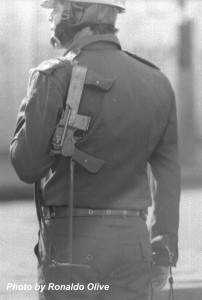
Firing Impressions
I was recently given the opportunity (courtesy of 40 BPM, or 4th Military Police Batallion) to fire these “museum pieces” during an informal shooting session. Though the 7.63mm ammunition was only recently manufactured in Brazil by CBC – Companhia Brasileira de Cartuchos – and supplies are still reasonable, I was supplied with German-made (Rheinish Westfalische Sprengstoff A.G.) “Patronen” of unidentified manufacture date. From the very disgusting appearance of both the boxes (some had termite-made holes in them!) and the rounds, I can almost bet the ammunition was contemporary to the guns. These, incidentally, had the manufacturer’s numbers in the80,000 range, meaning later production guns (the Schnellfeuer has its own sequence of serial numbers).
Has I taken a closer look at the rounds, I would have noticed that they all had a tiny crack running from the top of the case down to the bottleneck…upon firing, these little cracks resulted in cases rupturing about 1mm halfway down their lengths. Duds? About two or three out of every 50. Well, so much about the ammo.
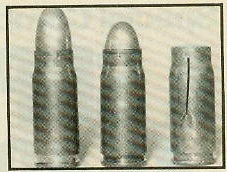
It had been raining off and on the day the Operations Officer of 40 BPM, Major Amendola, had set for the shooting session, so we mutually agreed not to drive to the Police range we were expected to use. Instead, we went to a practically deserted section in one nearby Rio de Janeiro borough, where dozers had been at work clearing an area with a steep hill at the back. It was muddy like hell, but safe, and it still had a large, rainmade “lake” at which I did most of the firing.
I started with a plain “Schnellfeuer” (serial number 80,170) with the wooden stock attached. The 10-round magazine is of the staggered-row, two-position feed type, real smooth to handload and operate. The magazine catch is located on the right side of the frame, within reach of the index finger. Like everybody else who has been handling Colt 1911A1-type pistols for a lifetime, I often found myself trying to find the catch with my thumb, on the left side of the grip…
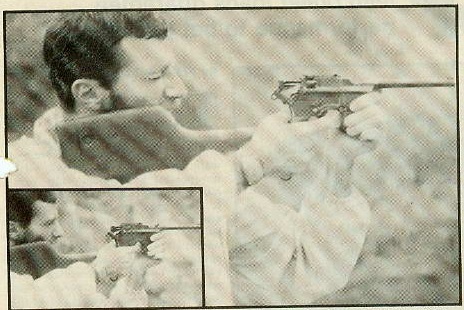
The safety catch is a lever that runs parallel to the hammer: pulled back and downward, the weapon is in the “fire” position; pushed up and forward is “safe.” Cocking is done by pulling the bolt backward by the ribbed rear end, and releasing it, which leaves the hammer in the cocked position, strips a round form the magazine and feeds it into the chamber.
Effective Range
The rear sight is of the tangent type, with 50 meter increments all the way to 1,000 meters, which is a lot of optimism, to say the least, even for a pistol with a comparatively long (132mm/5.2in) barrel. Though the 7.63mm (actual bullet caliber is 7.86mm) Mauser cartridge has a substantially flat trajectory and claims a maximum range of about 2,000 meters, realistic aimed fire (semi-auto, of course) is usually possible only up to a few hundred meters, nothing much above, say, 200 meters. My improvised range would only allow firings of to be conducted to about 50 meters, so the sight graduations were, in the event, a mere curiosity.
Some bushes and floating pieces of wood on the already-mentioned puddle were my targets, and even in fast, semiautomatic fire impact concentration was real good, and the resulting splashes were a visible proof of the Mauser’s inherent accuracy. One detail: the wooden stock fits somewhat high in the grip, not leaving too much space for the firing hand. The particularly long travel of the hammer (which, itself, is pretty large) may eventually “bite” the top of your hand, if no care is taken. [Ian’s note: on every single shot, in my experience!] So, myself being small-handed – and having previously warned of the hazard was a definite bonus in this case.
Some stove-pipe incidents occurred during the feeding process, and each and every time resulted in the bullet pushed as much as 4mm into the case, enlarging those tiny cracks in the brass. As ammo supply was not particularly abundant, most of the rounds were, in fact, reused and fired with no apparent problems. Throughout the firings, incidentally, no ejection/extraction problems occurred with any of the three guns, but feed incidents did show up.
When the last round is fires, the bolt remains open, a common feature in most semi-auto pistols, but which was pioneered by the Mauser.
Full Auto Failing
Then I turned to what I’ll call a “Modification One” gun (serial number 80,646), the one which retains the original pistol grip and holster/stock attachment. From the start, full-auto was selected, and I first elected not to fit the stock, using the two grips and firing from the hip. Even though the metal frame attachment and the considerably massive metal forward grip do make the pistol heavier and firmer to hold, firing bursts with it is not a practical proposition. The recoil of the 7.63mm Mauser round is, no doubt, very moderate, but the 900 rounds per minuteor so rate of fire, coupled to the small capacity of the magazine, means that you run out of ammunition in slightly over one second. And the muzzle does raise, and when you start trying to counter the momentum…the party is over!

In the semi-automatic mode, however, the modification proved okay; the wider grip base, plus the increased weight, makes the weapon a nasty little carbine. On the negative side, there’s still that somewhat awkward wooden stock, which complicates a little the grip of the firing hand (remember that hammer “bite”?).
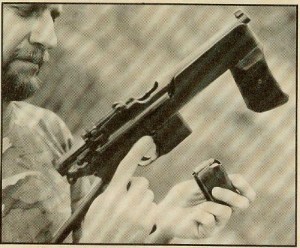
Maybe is was this that led to “Modification Two,” in which the rear grip was enlarged and flattened. The fixed metal stock attaches above where your hand is, thus providing a natural protection against the hammer. The so-modified Mauser takes on a compact submachinegun look, but as I was soon to find out during my shooting, that small-capacity magazine soon makes you forget about it. Maybe the 20-round mag (which, incidentally, was not supplied to Brazil) would help a little, more so a 40-round (!) one that was also reportedly manufactured once.
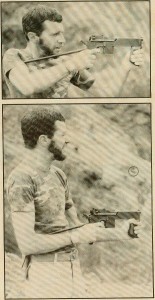
Firing from the shoulder, the skinny stock is just comfortable enough for the job, while in hip firing it helps in holding the gun steady, pressed against your side. It gives the Mauser an overall length of about 600mm (23.6in), which is well compact to be carried around and used in patrol cars, for example.
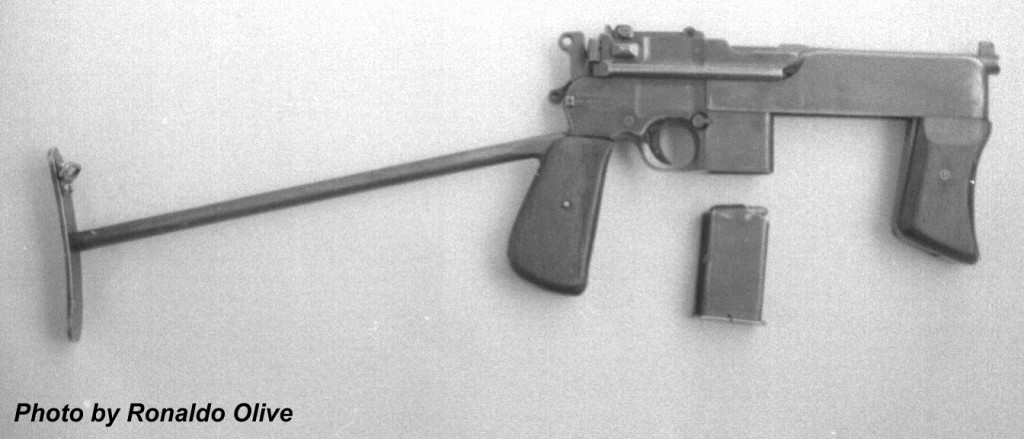
Together with the aging INAS (locally-made Madsen SMGs in .45 caliber), the veteran PASAMs are about to be retired, giving place to newer Brazilian-made submachineguns. And watch out, you collectors: it is reported that all but a small number of the PMRJ original and modified Mausers will be put up for sale, apparently in the international market. [Ian’s note: If you are reading this and happened to have bought one of these surplus guns back in the 80s, we’d love to hear your thoughts on them!]


i used to have a Schnellfeuer with stock holster, wow, that was some beutifull peice of gunmaking, totally useless on full auto though.
Very interesting find, thanks!
Oh yes, the hammer bite: grab it low so the convex swell of the grip fills the hollow of the palm (the pinkie might not find much to hold on nowadays, but in 1896 it sure did).
The pistol will then roll under recoil like a revolver, but won’t shoot itself into your fist like a hoglegged wheelgun would.
And no more manly brag afterwards about the lac’ed hand.
Sorry, guys.
Accuracy in full auto – forgettable, or negligible at best. Ammunition consumption – terrible: a 10-rd magazine dump takes less than a second, after two or three magazines you’d be able to master the trigger enough to squeeze two bursts from the 10 rd mag, or even three (with the last being typically a single shot). Cool factor – enormous, especially on a crowded range. But one word of caution to anyone with decent-sized palms: NEVER EVER wrap your strong hand’s thumb over the grip with your holster-stock attached. You’d never want to have a knuckle swallen that much, I can assure you. Hammer bite from one shot is peanuts compared to a beatting your knuckle gets from the hammer upon the fulcrum of the stock iron’s from a burst. The first time I shot it (it was actually an Astra 903) I did that mistake. My knuckle has swallen so much, that I wasn’t able to clench a fist for a whole week. From then on, I fired it many times, and can only say good things about it (except for accuracy in bursts and usage economy, of course). It will ruin your budget soon – or you’d ruin it soon, if you go for el cheapo Tokarev ammunition – dimensionally it’s the same round, but usually much hotter.
Agreed in all details.
With the stock attached you MUST shoot Norwegian style thumb to the right. And full auto was only an afterthought and realized by Karl Westinger (who later co-founded Feinwerkbau) when the Spanish shipped crates of poor copies to China.
Very interesting. I love the Mauser c96 pattern guns and these are my new favorites. The foregrip of the modification 1 gun appears to bear a striking resemblance to the rear grip of the Thompson (one of my other favorites). I find that interesting.
OMG I NEED one of these!!!!!
Not a Schnellfeuer-pistole, but mine anyway.
http://www.hunt101.com/data/500/medium/New_pictures_July_074.JPG
http://www.hunt101.com/data/500/medium/New_pictures_July_075.JPG
Dean from idaho
I think they replaced this with the Beretta M12S, built under license by Taurus (they’re very well made). Very easily held on target, even looks a little similar with the two grips.
The other SMG Ronaldo mentions, the Madsen M46/50, is one of the cheesiest pieces of stamped tin crap ever sold to soldiers anywhere. It makes a Resistance-built Mk II Sten copy look like the apogee of the machinist’s art….
I’m predisposed to like the Madsen M50 (I like the Madsen company’s general quirkiness), but I will say that the one I’ve had the chance to shoot had magazine issues serious enough that they prevented me from actually shooting it.
The locally-made Madsens for Brazil were the INA 50 and 53, in .45ACP rather than in 9x19mm as the original models. INA stands for Indústria Nacional de Armas, the company that produced the weapons royalty-free in Brazil thanks to the Danish recognition to a Brazilian Army officer who fled the country shortly before the German invasion, carrying with him (with Madsen’s knowledge) the drawings of the submachinegun, thus saving them from the Nazis!
Supposedly here in Belo Horizonte the Policia Militar received a shipment of 190 INA’s converted to 9mm a few years ago. I haven’t ever seen any on the street and even the MT-12 seems to be getting rare as well. “Gunspotting” is sort of a hobby of mine. In every major Brazilian police operation most of the officers are armed with modern weapons, but there always seems to be that one guy who went retro.
Last year I saw photos in my local Paper (Des Moines Register) Of Brazilian police after a fire fight in the slums. One of the officers was carrying a very short barreled Madsen LMG. There was no mistaking the drooping stock and the curved top mounted mag. If that old a LMG is still in use these modified Mauser’s could still show up.
Yep – there used to be a video on YouTube of a Brazilian police unit using a Madsen LMG in a gunfight, but it was taken down and I haven’t been able to find another copy. The policeman using it had wrapped the rear of the barrel shroud in cloth and held onto it there while firing from the shoulder and hip off a sling.
http://img819.imageshack.us/img819/5693/009nb.jpg
This is what I mean by retro.
IMBEL’s Fábrica de Itajubá modified many INAs to 9x19mm in the late 1980s, and I’ll be sending an article on that soon. The Madsen LMG seen in use by Rio de Janeiro Military Police in the mentioned video footage was a 7.62x51mm conversion also carried out by Fábrica de Itajubá, the original guns being in 7x57mm.
So Ronaldo, were these actually removed from service with the PMRJ, and if so, when? Many thanks!
What a fascinating modification, it is very reminiscent of Dillinger’s Colt M1911A1 .38 super machine pistol. It looks like it would be fun to shoot. Though, I would not feel very comfortable with my supporting hand that close to the muzzle blast! Thanks for posting this gun.
The Mauser 1896 pistol’s forward grip more closely resembles the Thompson SMG but it should be moved back to directly in front of the magazine well since placing it far to the front requires the shooter to extend his support arm.
Fantastic piece – I was enlightened by the insight ! Does anyone know if my assistant could get access to a fillable MI RI-060 version to work with ?